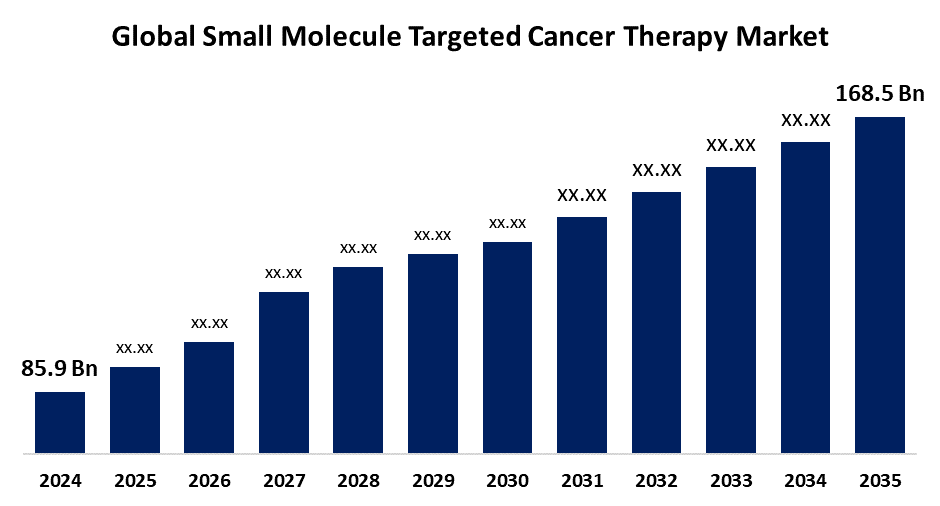Global Small Molecule Targeted Cancer Therapy Market Size, Share, and COVID-19 Impact Analysis, By Type (Monoclonal Antibodies, Small Molecules, and Small Molecule Drug Conjugates), By Application (Lymphoma, Melanoma, Multiple Myeloma, Breast Cancer, and Prostate Cancer), and By Region (North America, Europe, Asia-Pacific, Latin America, Middle East, and Africa), Analysis and Forecast 2025 - 2035.
Industry: HealthcareGlobal Small Molecule Targeted Cancer Therapy Market Insights Forecasts to 2035
- The Global Small Molecule Targeted Cancer Therapy Market Size Was Estimated at USD 85.9 Billion in 2024
- The Market Size is Expected to Grow at a CAGR of around 6.32% from 2025 to 2035
- The Worldwide Small Molecule Targeted Cancer Therapy Market Size is Expected to Reach USD 168.5 Billion by 2035
- Asia Pacific is expected to Grow the fastest during the forecast period.

Get more details on this report -
The Global Small Molecule Targeted Cancer Therapy Market Size was worth around USD 85.9 Billion in 2024 and is predicted to Grow to around USD 168.5 Billion by 2035 with a compound annual growth rate (CAGR) of 6.32% from 2025 to 2035. The rising frequency of cancer incidence, increasing healthcare expenditure, and advancements in personalized medicine are driving the small molecule targeted cancer therapy market worldwide.
Market Overview
The small molecule targeted cancer therapy market is an industry that emphasizes the development and commercialization of drugs specifically targeting and inhibiting molecules involved in cancer growth and progression. Small molecule targeted cancer therapy involves the use of drugs with low molecular weight to interfere with specific molecules (targets) within cancer cells, disrupting their growth and survival. Compared with traditional chemotherapy drugs, targeted drugs have high potency and low toxicity as they specifically target cancer cells but spare normal cells. Various cancer types including multiple myeloma, prostate cancer, melanoma, lymphoma, and breast cancer are treated with targeted therapy. A wide range of small molecule targeted therapies have been developed, with rapid advancements in drug discovery and development.
Advancements in genomic sequencing technologies, for identifying rare genetic abnormalities and biomarkers linked to cancers, enable pharmaceutical companies to develop targeted medicine matched to specific genetic profiles in order to enhance treatment precision and efficacy, is escalating the market growth opportunities.
Report Coverage
This research report categorizes the small molecule targeted cancer therapy market based on various segments and regions, forecasts revenue growth, and analyzes trends in each submarket. The report analyses the key growth drivers, opportunities, and challenges influencing the small molecule targeted cancer therapy market. Recent market developments and competitive strategies such as expansion, type launch, development, partnership, merger, and acquisition have been included to draw the competitive landscape in the market. The report strategically identifies and profiles the key market players and analyses their core competencies in each sub-segment of the small molecule targeted cancer therapy market.
Global Small Molecule Targeted Cancer Therapy Market Report Coverage
| Report Coverage | Details |
|---|---|
| Base Year: | 2024 |
| Market Size in 2024: | USD 85.9 Billion |
| Forecast Period: | 2025-2035 |
| Forecast Period CAGR 2025-2035 : | 6.32% |
| 2035 Value Projection: | USD 168.5 Billion |
| Historical Data for: | 2020-2023 |
| No. of Pages: | 203 |
| Tables, Charts & Figures: | 100 |
| Segments covered: | By Type, By Application and By Region |
| Companies covered:: | Bayer AG, GlaxoSmithKline plc., Boehringer Ingelheim International GmbH, Johnson & Johnson, AstraZeneca, Pfizer Inc., Novartis AG, Sanofi, AbbVie Inc., Eli Lilly and Company, CYTOKINETICS, INC, AVEO Pharmaceuticals, Inc., Teva Pharmaceutical Industries Ltd., and Others |
| Pitfalls & Challenges: | COVID-19 Impact, Challenges, Future, Growth, & Analysis |
Get more details on this report -
Driving Factors
The increased prevalence of cancer, owing to several factors including changing lifestyle and an increase in longevity, as well as social & economic changes, is anticipated to drive the market demand for small molecule targeted therapy. The global economic cost of cancer between the year 2020 to 2050 was estimated to be $25.2 trillion. Thus, the increasing need for global efforts to curb the ongoing burden of cancers is contributing to driving the market. Further, the emergence of personalized medicine that enables treatment to an individual’s specific genetic and molecular characteristics, for optimized treatment effectiveness and minimum side effects, is promoting the market.
Restraining Factors
Drug resistance due to the adaptation and resistance developed by cancer cells is challenging the market growth. Further, the increased research & development cost as well as complex manufacturing processes of these drugs may hamper the market. Further, the stringent regulatory policies associated with the approval of novel drugs are anticipated to restrain the market growth.
Market Segmentation
The small molecule targeted cancer therapy market share is classified into type and application.
- The small molecules segment dominated the market with the largest market share in 2024 and is projected to grow at a substantial CAGR during the forecast period.
Based on the type, the small molecule targeted cancer therapy market is divided into monoclonal antibodies, small molecules, and small molecule drug conjugates. Among these, the small molecules segment dominated the market with the largest market share in 2024 and is projected to grow at a substantial CAGR during the forecast period. Small molecules have better cell penetration, simpler synthesis, lower cost, oral bioavailability, and reach intracellular targets. Further, it is easily structurally modified to make it more applicable to clinical needs, and convenient to promote due to its low cost. The increased effectiveness of small molecules targeted cancer therapy with lower side effects is driving the market.
- The breast cancer segment accounted for the dominant market share in 2024 and is anticipated to grow at a significant CAGR during the forecast period.
Based on the application, the small molecule targeted cancer therapy market is divided into lymphoma, melanoma, multiple myeloma, breast cancer, and prostate cancer. Among these, the breast cancer segment accounted for the dominant market share in 2024 and is anticipated to grow at a significant CAGR during the forecast period. Targets of small-molecule targeted therapy in breast cancer include signalling pathways (receptor tyrosine kinases), membrane receptors (EGFR inhibitors), and some regulatory proteins, like PARP proteins. HER2 inhibitors, CDK4/6 inhibitors, PARP inhibitors, and antibody-drug conjugates are some of the targeted therapies for breast cancer. For instance, Abemaciclib, ado-trantuzumab emtansine, palbociclib, trastuzumab, and other target drug therapies are involved in small molecule targeted cancer therapy for breast cancer.
Regional Segment Analysis of the Small Molecule Targeted Cancer Therapy Market
- North America (U.S., Canada, Mexico)
- Europe (Germany, France, U.K., Italy, Spain, Rest of Europe)
- Asia-Pacific (China, Japan, India, Rest of APAC)
- South America (Brazil and the Rest of South America)
- The Middle East and Africa (UAE, South Africa, Rest of MEA)
North America is anticipated to hold the largest share of the small molecule targeted cancer therapy market over the predicted timeframe.

Get more details on this report -
North America is anticipated to hold the largest share of the small molecule targeted cancer therapy market over the predicted timeframe. The growing prevalence of cancer, presence of advanced health facilities, increasing healthcare expenditure, along with prioritization towards therapies with minimal side effects are driving the small molecule targeted cancer therapy market. Further, the existence of top leading pharmaceutical corporations and academic research facilities, as well as a supportive regulatory framework, is contributing to promoting the market.
Asia Pacific is expected to grow at a rapid CAGR in the small molecule targeted cancer therapy market during the forecast period. An increasing prevalence of cancer, including liver, stomach, and prostate cancers, with the presence of a large population base in the region, is responsible for driving the market demand. The specificity of the therapy toward cancer cells, sparing toxicity to off-target cells, contributes to propelling the market for small molecule targeted cancer therapy. Further, government initiatives, awareness, and healthcare spending are all factors that are promoting the market in the region.
Europe is anticipated to hold a significant share of the small molecule targeted cancer therapy market during the projected timeframe. With the increasing awareness about cancer and its advanced therapies, the development of novel therapies is driving the small molecule targeted cancer therapy market growth. In addition, the ongoing investments in biopharmaceutical R&D and clinical trials in the countries of the region, with the presence of improved healthcare infrastructure, are promoting the market growth.
Competitive Analysis:
The report offers the appropriate analysis of the key organizations/companies involved within the small molecule targeted cancer therapy market, along with a comparative evaluation primarily based on their type of offering, business overviews, geographic presence, enterprise strategies, segment market share, and SWOT analysis. The report also provides an elaborative analysis focusing on the current news and developments of the companies, which includes type development, innovations, joint ventures, partnerships, mergers & acquisitions, strategic alliances, and others. This allows for the evaluation of the overall competition within the market.
- Bayer AG
- GlaxoSmithKline plc.
- Boehringer Ingelheim International GmbH
- Johnson & Johnson
- AstraZeneca
- Pfizer Inc.
- Novartis AG
- Sanofi
- AbbVie Inc.
- Eli Lilly and Company
- CYTOKINETICS, INC
- AVEO Pharmaceuticals, Inc.
- Teva Pharmaceutical Industries Ltd.
- Others
Key Target Audience
- Market Players
- Investors
- End-users
- Government Authorities
- Consulting And Research Firm
- Venture capitalists
- Value-Added Resellers (VARs)
Market Segment
This study forecasts revenue at global, regional, and country levels from 2020 to 2035. Spherical Insights has segmented the small molecule targeted cancer therapy market based on the below-mentioned segments:
Global Small Molecule Targeted Cancer Therapy Market, By Type
- Monoclonal Antibodies
- Small Molecules
- Small Molecule Drug Conjugates
Global Small Molecule Targeted Cancer Therapy Market, By Application
- Lymphoma
- Melanoma
- Multiple Myeloma
- Breast Cancer
- Prostate Cancer
Global Small Molecule Targeted Cancer Therapy Market, By Regional Analysis
- North America
- US
- Canada
- Mexico
- Europe
- Germany
- UK
- France
- Italy
- Spain
- Russia
- Rest of Europe
- Asia Pacific
- China
- Japan
- India
- South Korea
- Australia
- Rest of Asia Pacific
- South America
- Brazil
- Argentina
- Rest of South America
- Middle East & Africa
- UAE
- Saudi Arabia
- Qatar
- South Africa
- Rest of the Middle East & Africa
Frequently Asked Questions (FAQ)
-
1. What is the CAGR of the small molecule targeted cancer therapy market over the forecast period?The global small molecule targeted cancer therapy market is projected to expand at a CAGR of 6.32% during the forecast period.
-
2. What is the market size of the small molecule targeted cancer therapy market?The global small molecule targeted cancer therapy market size is expected to grow from USD 85.9 Billion in 2024 to USD 168.5 Billion by 2035, at a CAGR of 6.32% during the forecast period 2025-2035.
-
3. Which region holds the largest share of the small molecule targeted cancer therapy market?North America is anticipated to hold the largest share of the small molecule targeted cancer therapy market over the predicted timeframe.
Need help to buy this report?